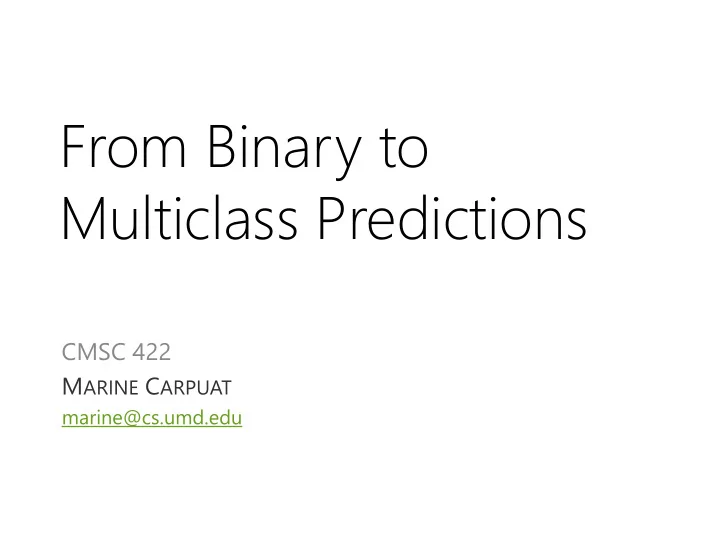

From Binary to Multiclass Predictions CMSC 422 M ARINE C ARPUAT marine@cs.umd.edu
T opics Given an arbitrary method for binary classification, how can we learn to make multiclass predictions? Fundamental ML concept: reductions
Multiclass classification • Real world problems often have multiple classes (text, speech, image, biological sequences…) • How can we perform multiclass classification? – Straightforward with decision trees or KNN – Can we use the perceptron algorithm?
Reductions • Idea is to re-use simple and efficient algorithms for binary classification to perform more complex tasks • Works great in practice: – E.g., Vowpal Wabbit
One Example of Reduction: Learning with Imbalanced Data Subsampling Optimality Theorem: If the binary classifier achieves a binary error rate of ε , then the error rate of the α -weighted classifier is α ε
T oday: Reductions for Multiclass Classification
How many classes can we handle in practice? • In most tasks, number of classes K < 100 • For much larger K – we need to frame the problem differently – e.g, machine translation or automatic speech recognition
Reduction 1: OVA • “One versus all” (aka “one versus rest”) – Train K-many binary classifiers – classifier k predicts whether an example belong to class k or not – At test time, • If only one classifier predicts positive, predict that class • Break ties randomly
Time complexity • Suppose you have N training examples, in K classes. How long does it take to train an OVA classifier – if the base binary classifier takes O(N) time to learn? – if the base binary classifier takes O(N^2) time to learn?
Error bound • Theorem: Suppose that the average error of the K binary classifiers is ε , then the error rate of the OVA multiclass classifier is at most (K-1) ε • To prove this: how do different errors affect the maximum ratio of the probability of a multiclass error to the number of binary errors (“ efficiency ”)?
Error bound proof • If we have a false negative on one of the binary classifiers (assuming all other classifiers correctly output negative) • What is the probability that we will make an incorrect multiclass prediction? (K – 1) / K Efficiency: ( K – 1) / K / 1 = (K – 1 ) / K
Error bound proof • If we have k false positives with the binary classifiers • What is the probability that we will make an incorrect multiclass prediction? – If there is also a false negative: 1 • Efficiency =1 / k + 1 – Otherwise k / ( k + 1) • Efficiency = k / (k + 1) / k = 1 / ( k + 1)
Error bound proof • What is the worst case scenario? – False negative case: efficiency is (K-1)/K • Larger than false positive efficiencies – There are K-many opportunities to get false negative, overall error bound is (K-1) ε
Reduction 2: AVA • All versus all (aka all pairs) • How many binary classifiers does this require?
Time complexity • Suppose you have N training examples, in K classes. How long does it take to train an AVA classifier – if the base binary classifier takes O(N) time to learn? – if the base binary classifier takes O(N^2) time to learn?
Error bound • Theorem: Suppose that the average error of the K binary classifiers is ε , then the error rate of the AVA multiclass classifier is at most 2(K-1) ε • Question: Does this mean that AVA is always worse than OVA?
Extensions • Divide and conquer – Organize classes into binary tree structures • Use confidence to weight predictions of binary classifiers – Instead of using majority vote
T opics Given an arbitrary method for binary classification, how can we learn to make multiclass predictions? OVA, AVA Fundamental ML concept: reductions
A taste of more complex problems: Collective Classification • Examples: – object detection in an image – finding part of speech of words in a sentence
How would you address collective classification?
Recommend
More recommend